Ustalenia i wyniki od 2019 r
Bezpłatne pliki do pobrania:
1. Wprowadzenie
Dwa pytania od czasu odkrycia rewitalizacji wody GRANDER® zwracają ostatnio uwagę: jak działa rewitalizacja wody GRANDER® i jakie jest naukowe wyjaśnienie obserwowanych efektów?
Codzienne użytkowanie i liczne pozytywne dowody udokumentowane empirycznie mówiono jasnym językiem dziesięciolecia przed znalezieniem naukowego wyjaśnienia.
Dzięki nowo utworzonym gałęziom badań, w tym stosowanej fizyce wody (1) i ulepszonym procedurom analizy wody (2), podstawowe mechanizmy, a także poszczególne czynniki rewitalizacji wody GRANDER® są dziś kompleksowo zrozumiane, weryfikowane i powtarzalne w laboratorium.
Zastosowana fizyka wody
Fizyka stosowana wody to dziedzina naukowa zajmująca się podstawowymi właściwościami wody, w tym jej oddziaływaniem z polami elektrycznymi, magnetycznymi i elektromagnetycznymi oraz wpływem tych współzależności na organizmy żywe, takie jak bakterie.
Wiele badań zbadało skutki magnetycznego lub elektromagnetycznego uzdatniania wody w ciągu ostatnich 40 lat, o czym świadczy ponad sto artykułów i raportów na ten temat (przykład: wyciąg (10–29)).
Przez wiele lat społeczność naukowa bardzo wątpiła w twierdzenie, że pola magnetyczne wpływają na twardą wodę, a tym samym na strukturę i morfologię krystalizacji węglanu wapnia. Wynika to głównie z faktu, że nie był znany żaden wiarygodny mechanizm, który mógłby wyjaśnić utrzymujący się wpływ pól magnetycznych nawet po ekspozycji.
Z tego powodu stosowanie tej zasady było kontrowersyjne, nie tylko z powodu w odniesieniu do rewitalizacji wody GRANDER®.
WETSUS - Europejskie Centrum Doskonałości Technologii Zrównoważonej Wody
Interdyscyplinarna współpraca badawcza obejmująca kilka europejskich uniwersytetów i instytucji badawczych (3) realizowana w ramach WETSUS - Europejskiego Centrum Doskonałości Technologii Zrównoważonej Wody, przyniosła przełom w rozumieniu magnetycznego uzdatniania wody (MWT) opartego na zasadach fizyka wody. (4)
Podsumowanie wyników badań:
Wyniki badań dr Elmara Fuchsa (5) i jego zespołu / WETSUS (6), patrz „Silne gradienty w słabych polach magnetycznych wywołują powstawanie DOLLOP w wodzie z kranu” zostały zweryfikowane w procesie recenzji. (7)
W 2012 r. Coey zaproponował teorię wyjaśniającą mechanizm magnetycznego uzdatniania wody na podstawie gradientu zastosowanego pola zamiast jego siły bezwzględnej.
Ostatnie ustalenia grupy badawczej „Applied Water Physics” z WETSUS (Martina Sammer, Cees Kamp, Astrid H. Paulitsch-Fuchs, Adam D. Wexler, Cees JN Buisman i Elmar C. Fuchs) opierają się na odkryciu, że nanocząsteczki węglanu wapnia („DOLLOP”) zawarte w wodzie wodociągowej reorganizują się w pewnych warunkach (które są między innymi spowodowane gradientem magnetycznym) iw tym procesie zmieniają czynniki środowiskowe dla substancji rozpuszczonych (takich jak wapno). (8)
Badanie pokazuje wzrost klastrów poprzedzających zarodkowanie wielkości nm (dynamicznie uporządkowanych płynnych polimerów oksyanionowych lub „DOLLOP”) spowodowanych ekspozycją na pole magnetyczne. Efekt ten jest zgodny z teorią Coeya, pokazując, że ma on również zastosowanie do bardzo słabych pól magnetycznych, pod warunkiem że występują silne gradienty.
2. Nowe procedury analizy wody
Zaawansowane metody badawcze otwierają nowe możliwości w nowoczesnej analizie wody. Dotyczy to analizy śladowej, która służy do określania stężenia materiałów lub substancji (pg / l), a także do badań mikrobiologicznych, na przykład do wykrywania liczby bakterii w wodzie w ciągu jednej godziny.
Metody zachowawcze zajmują 72 godziny, aby ustalić całkowitą liczbę bakterii w wodzie pitnej. Co więcej, tylko ok. 1% istniejących bakterii można uwidocznić, a pozostałe 99% pozostaje zasłonięte.
Cytometria przepływowa
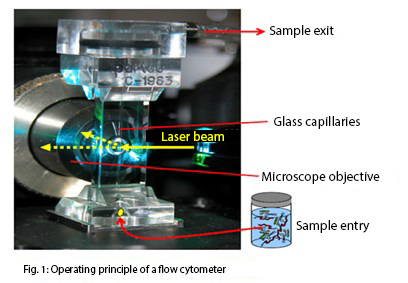 Cytometria przepływowa podsumowuje 99% bakterii w wodzie, a nawet rozróżnia żywe i martwe komórki. Wymagany czas: 1 godzina
Cytometria przepływowa podsumowuje 99% bakterii w wodzie, a nawet rozróżnia żywe i martwe komórki. Wymagany czas: 1 godzina
W cytometrii przepływowej analizowane są poszczególne komórki przepływające obok źródła napięcia elektrycznego lub światła (wiązki laserowe w większości konfiguracji) z dużą prędkością. W zależności od kształtu, struktury i koloru komórek powstają różne efekty, z których można wywnioskować właściwości poszczególnych komórek.
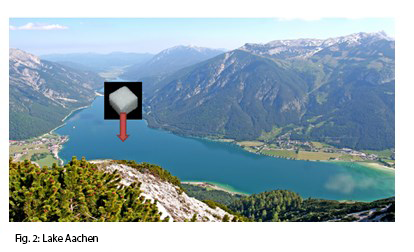
3. Scientific papers
A recently published peer-reviewed scientific paper presents evidence for the difference between regular and revitalized water. (7)
‘Strong Gradients in Weak Magnetic Fields Induce DOLLOP Formation in Tap Water’
Martina Sammer 1, Cees Kamp 2, Astrid H. Paulitsch-Fuchs 1, Adam D. Wexler 1, Cees J. N. Buisman 1 and Elmar C. Fuchs 1*,
1 Wetsus, European Centre of Excellence for Sustainable Water Technology, Oostergoweg 9, 8911 MA Leeuwarden, The Netherlands; martina.sammer@wetsus.nl (M.S.); astrid.paulitsch-fuchs@wetsus.nl (A.H.P.-F.); adam.wexler@wetsus.nl (A.D.W.); cees.buisman@wetsus.nl (C.J.N.B.)
2 Kamp Consult, Deventerweg 81, 7203 AD Zutphen, The Netherlands; ceeskamp@xs4all.nl
*Correspondence: elmar.fuchs@wetsus.nl; Tel.: +31-58-284-3162
Academic editor: Wilhelm Püttmann
Received: 21 January 2016; accepted: 23 February 2016; published: 3 March 2016
Results:
- Revitalization changes the alternating current resistance (impedance) in water
- Revitalization fosters an increased formation of lime nanoparticles (so-called DOLLOPs) in water
These phenomena could be observed using three independent research methods.
a) Impedance spectroscopy
An AC current is generated in a measuring cell filled with the water to be tested. In doing so, the AC current’s frequency is modified, and the electrical AC resistance (impedance) and the phase shift of the sample are established.
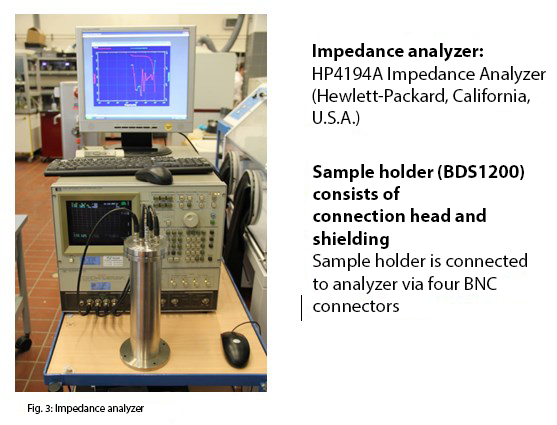
Varying with frequency, significant differences between samples of regular water (8) and water revitalized with GRANDER® could be observed:
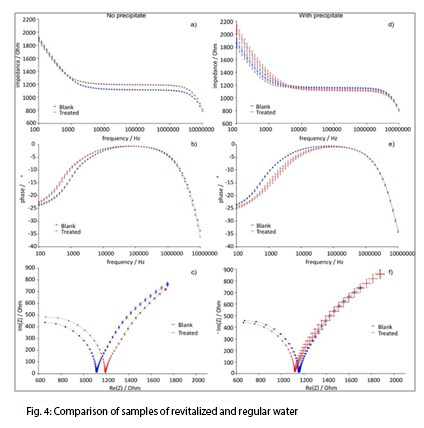
Note: the proposed DOLLOP formation was tested in at least 16 independent experiments. 12 measurements per experiment, each encompassing complex impedance at 65 frequencies, measurement of two parameters (phase and impedance) per frequency. (8)
b) Laser scattering

The number of calcium carbonate nanoparticles (DOLLOPs) was measured using flow cytometry. (8)
c) Scanning electron microscopy
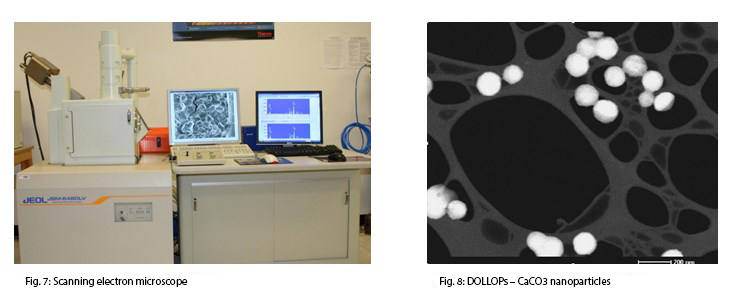
Following a revitalization of the water with GRANDER®, DOLLOP formation was increased. DOLLOPs can act as crystal nuclei, and, as such, influence lime deposit behavior. (8)(9)
4. Interpretation of results with regard to GRANDER® effects
a) Change in deposit behavior
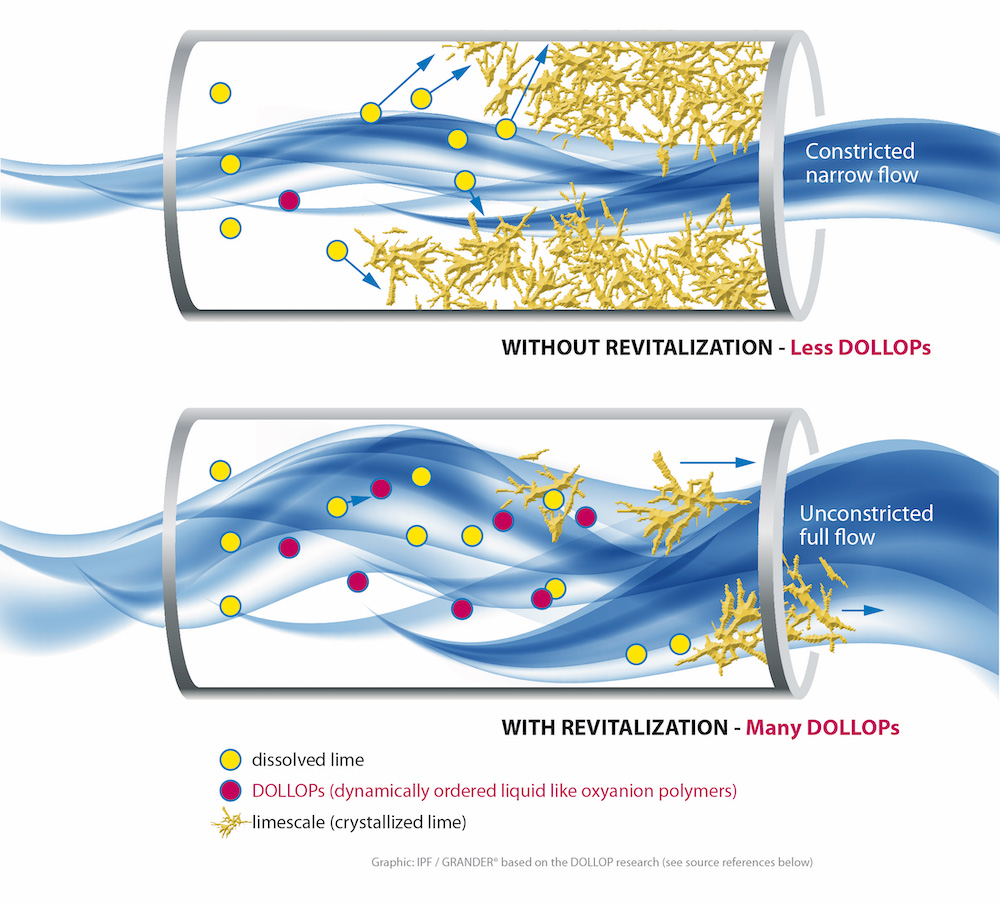
Fewer DOLLOPs without revitalization
Dissolved lime crystallizes on pipe walls, gradually constricting the pipes (9)
A crystallization of dissolved lime on pipe walls produces detrimental effects such as a constriction of pipes and an increase in flow resistance. Moreover, a rougher surface due to lime deposits is good breeding ground for harmful bacteria and biofilms.
Many DOLLOPs with revitalization
Dissolved lime already crystallizes in the water due to DOLLOPs and is flushed out (9)
In water with a high concentration of DOLLOPs, crystallization starts already in the water and hardly affects pipe walls. As a result, crystals are not deposited on the pipes but are flushed out with the water stream. (8)
b) Improved self-cleaning properties
The water’s background flora (autochthonous bacteria) works like an immune system. It protects the water from harmful bacteria in a natural way by consuming nutrients due to its activities, depriving unwanted bacteria of their sustenance.
This process is a fierce competition in which usually only ‘healthy’ flora prevails.
Please note that if the system is infiltrated with an excess amount of pollutants, GRANDER® should be combined with conventional water treatment methods to produce the desired effects.
What are the results of increased self-cleaning properties?
- Water can be stored for longer
- Reduced risk of bacterial growth
- Increased microbiological stability
- Increased resilience of water
Using flow cytometry, it could be shown that GRANDER® water revitalization supports the water’s background flora and thus its resilience.
5. Benefits of GRANDER® effects
Example: likelihood of deposit formation
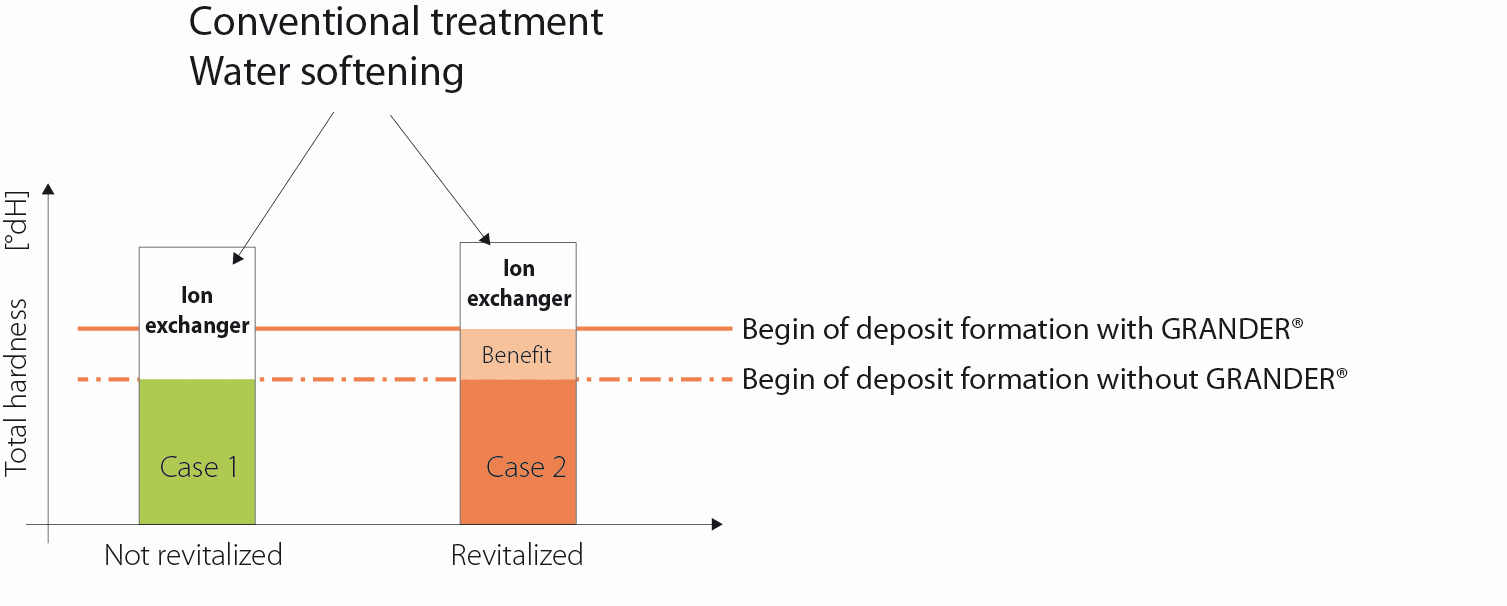
Fig. 1: Likelihood of deposits
Water can dissolve lime. In this process, the pH value and the temperature are important parameters. The mineral saturation state is another factor determining the amount of lime in solution and the threshold value from which it starts to crystallize.
In revitalized water, deposits start to form from a higher water hardness threshold value compared to regular water. For very hard water and unfavorable conditions, a combination with conventional water treatment methods (ion exchanger) is recommended in order to prevent lime deposits.
Effects of water revitalization regarding deposits
- Revitalized water tolerates a higher degree of water hardness without deposit formation
- Combined use with an ion exchanger allows for an upward adjustment of residual hardness
- Reduces expenses for chemicals, electricity, and maintenance
- Improved taste
Example: microbiological stability:
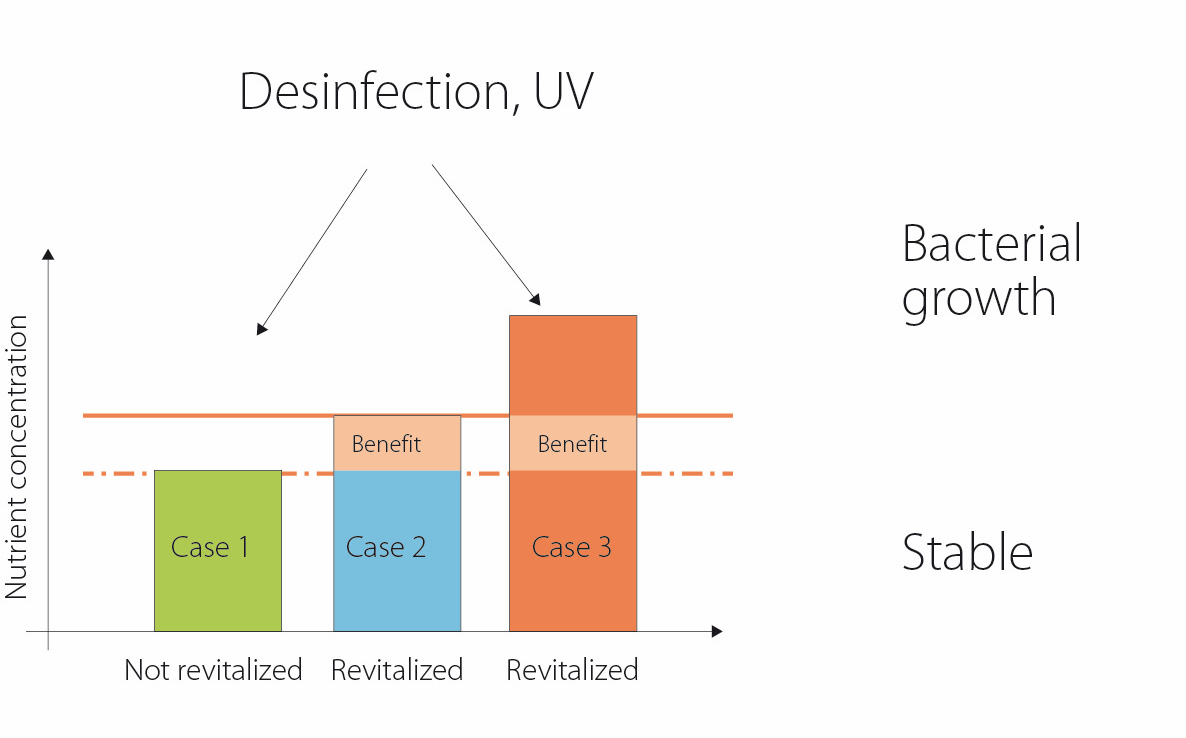
Fig. 11: Example: microbiological stability
Bacteria need nutrients and a certain environment to exist and multiply in the water.
In revitalized water, the natural background flora is more active, using up more nutrients and creating a bulwark against unwanted bacteria.
For systems frequently contaminated with large amounts of pollutants, a combination with conventional treatment methods is recommended.
Effects of water revitalization regarding microbiological stability
- Higher microbiological stability
- Revitalized water remains stable also at higher nutrient concentration
- Reduces expenses for chemicals, electricity, and maintenance (9)
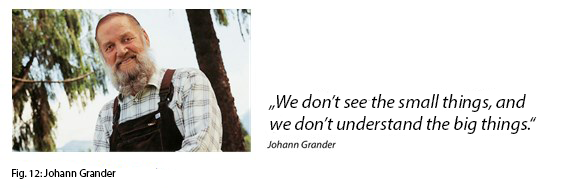
Thanks to advances in modern measuring technologies, we are starting to get a glimpse of what is happening in water revitalization! Johann Grander was decades ahead of us in understanding these phenomena.
Visions for a sustainable future
Using the natural strengths
of revitalized water is an
important step towards
sustainability and health.
The stronger and unadulterated water is,
the less treatment it needs.
This saves resources, protects nature,
and also saves a penny.
Our philosophy is to
strengthen the positive forces of water,
helping it maintain a natural balance.
Sources:
(1) Link: https://www.wetsus.nl/research/research-themes/applied-water-physics
(2) Link: Link
(3) List of universities: https://www.wetsus.nl/research/research-institutes
(4) Coey, J. M. D. (2012). Magnetic water treatment – how might it work? Philosophical Magazine, 92(31), 3857–3865.
(5) Homepage Dr. Elmar C. Fuchs - http://ecfuchs.com/
(6) WETSUS – Applied Water Physics - https://www.wetsus.nl/research/research-themes/applied-water-physics
(7) https://www.mdpi.com/2073-4441/8/3/79/pdf
(8) Strong Gradients in Weak Magnetic Fields Induce DOLLOP Formation in Tap Water
Cees J. N. Buisman and Elmar C. Fuchs , Martina Sammer , Cees Kamp , Astrid H. Paulitsch-Fuchs , Adam D. Wexler
Wetsus, European Centre of Excellence for Sustainable Water Technology, MA Leeuwarden
Received: 21 January 2016; accepted: 23 February 2016; published: 3 March 2016
(9) IPF GmbH
(10) Josh, K.M.; Kamat, P.V. Effect of magnetic field on the physical properties of water. J. Ind. Chem. Soc. 1966, 43,620–622.
(11) Duffy, E.A. Investigation of Magnetic Water Treatment Devices. Ph.D. Thesis, Clemson University, Clemson, SC, USA, 1977.
(12) Lin, I.; Yotvat, J. Exposure of irrigation and drinking water to a magnetic field with controlled power and direction. J. Mag. Magn. Mat. 1990, 83, 525–526.
(13) Higashitani, K.; Kage, A.; Katumura, S.; Imai, K.; Hatade, S. Effects of a magnetic field on the formation of CaCO3 particles. J. Colloid Interface Sci. 1993, 156, 90–95.
(14) Gehr, R.; Zhai, Z.A.; Finch, J.A.; Rao, S.R. Reduction of soluble mineral concentrations in CaSO4 saturated water using a magnetic field. Water Res. 1995, 29, 933–940.
(15) Baker, J.S.; Judd, S.J. Magnetic amelioration of scale formation. Water Res. 1996, 30, 247–260.
(16) Pach, L.; Duncan, S.; Roy, R.; Komarneni, S. Effects of a magnetic field on the precipitation of calcium carbonate. J. Mater. Sci. Lett. 1996, 15, 613–615.
(17) Wang, Y.; Babchin, A.J.; Chernyi, L.T.; Chow, R.S.; Sawatzky, R.P. Rapid onset of calcium carbonate crystallization under the influence of a magnetic field. Water Res. 1997, 31, 346–350.
(18) Parsons, S.A.;Wang, B.L.; Judd, S.J.; Stephenson, T. Magnetic treatment of calcium carbonate scale-effect of pH control. Water Res. 1997, 31, 339–342.
(19) Barrett, R.A.; Parsons, S.A. The influence of magnetic fields on calcium carbonate precipitation. Water Res. 1998, 32, 609–612.
(20) Colic, M.; Morse, D. The elusive mechanism of the magnetic 'memory'of water. Colloid Surface A 1999, 154, 167–174.
(21) Goldsworthy, A.; Whitney, H.; Morris, E. Biological effects of physically conditioned water. Water Res. 1999, 33, 1618–1626.
(22) Coey, J.M.D.; Cass, S. Magnetic water treatment. J. Magn. Magn. Mater. 2000, 209, 71–74.
(23) Hołysz, L.; Chibowski, E.; Szcze´s, A. Influence of impurity ions and magnetic field on the properties of freshly precipitated calcium carbonate. Water. Res. 2003, 37, 3351–3360.
(24) Kobe, S.; Draži´c, G.; McGuiness, P.J.; Meden, T.; Sarantopolou, E.; Kollia, Z.; Sefalas, A.C. Control over nanocrystalization in turbulent flow in the presence of magnetic fields. Mater. Sci. Eng. 2003, 23, 811–815.
(25) Knez, S.; Pohar, C. The magnetic field influence on the polymorph composition of CaCO3 precipitated from carbonized aqueous solutions. J. Colloid Interface Sci. 2005, 281, 377–388.
(26) Fathia, A.; Mohamed, T.; Claude, G.; Maurin, G.; Mohamed, B.A. Effect of a magnetic water treatment on homogeneous and heterogeneous precipitation of calcium carbonate. Water Res. 2006, 40, 1941–1950.
(27) Li, J.; Liu, J.; Yang, T.; Xiao, C. Quantitative study of the effect of electromagnetic field on scale deposition on nanofiltration membranes via UTDR. Water Res. 2007, 41, 4595–4610.
(28) Katsir, Y.; Miller, L.; Aharanov, Y.; Jacob, E.B. The effect of rf-irradiation on electrochemical deposition and its stabilization by nanoparticle doping. J. Electrochem. Soc. 2007, 154, 249–259.
(29) Hołysz, L.; Szcze´s, A.; Chibowski, E. Effects of a static magnetic field on water and electrolyte solutions. J. Colloid Interface Sci. 2007, 316, 996–1002.
 GRANDER® Polska
GRANDER® Polska 
